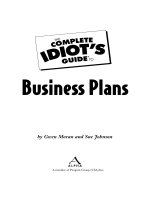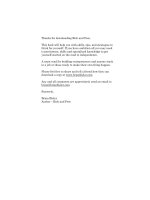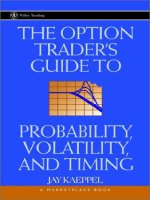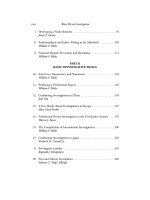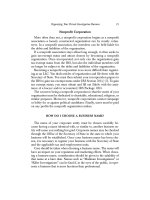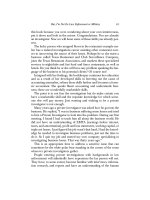The option trader s guide to probability volatility and timing phần 9 pot
Bạn đang xem bản rút gọn của tài liệu. Xem và tải ngay bản đầy đủ của tài liệu tại đây (773.78 KB, 29 trang )
the stock rallied above 35 and the option was exercised against
us. On the downside, we entered a stop-loss to sell the stock at
29. A drop in this price would require a drop back into the previ-
ous trading range and would be a signal to us that the recent
breakout had failed. If our stop-loss price for the stock is hit, we
will simultaneously buy back the call option to avoid holding a
short naked call position. Remember that holding a naked short
call exposes you to unlimited risk.
Position Management
Stop-loss: Sell the stock and buy back the call option if the stock
drops below 29.
Profit-taking: If the stock rises, hold until option expiration or
until the stock is called away.
As shown in Figure 18.4, CA stock failed to follow through to
the upside and drifted sideways to slightly higher through Febru-
ary option expiration. At the close of trading on option-expiration
day, the stock was trading at 35.90. As a result, the 35 call was
0.90 point in the money. If we did not buy this call back before
218 The Option Trader’s Guide
3900
3552
3204
2856
2508
2160
1812
1024 1109 1130 1219 10109 10130 10216
Figure 18.4 Computer Associates at February option expiration.
More free books @ www.BingEbook.com
the close of trading, it would automatically be exercised by the
Options Clearing Corporation and our stock would be called
away. If we had wanted to continue to hold the stock, we would
have to buy back the call before the close of trading on that day.
In this example, writing a covered call helped us achieve the
best of both worlds. The stock rose from 33.69 to 35.90, generat-
ing a profit of $221. At the same time, the February 35 call lost
all of its time premium and declined in price from 2.50 to 0.90 at
expiration, generating another profit of $160 to the writer of this
option (Table 18.2).
The end result is that as of February option expiration we
have a profit of $380 and would still be holding our stock posi-
tion if we bought back the call just before expiration. If we held
the option through expiration, our stock position would be
called away because our short option is in the money, thus trig-
gering automatic exercise.
Write a Covered Call 219
KEY POINT
Covered call writing should be considered only when implied volatility is
high. Sell only out-of-the-money call options to maximize the effects of time
decay.
Trade Result
Option expired at 0.90 on February 16.
Stock closed at 35.90.
Table 18.2 Computer Associates Covered Call Result
Long/Short Quantity Type Price In Last Price $ + /–
Long 100 Shares 33.69 35.90 +$221
Short 1 February 35 call 2.50 0.90 +$160
More free books @ www.BingEbook.com
Writing Covered Calls without Limiting Upside
Potential
As you can see in Figure 18.5, the primary negative associated
with writing covered calls against your entire underlying posi-
tion is that you put yourself into a trade that has unlimited
downside risk and only limited profit potential. If the stock you
are holding collapses, you stand to take a large loss, reduced
somewhat by the option premium you collected. If, however,
the underlying security surprises you by advancing far more than
you expected, you will not participate in any profit above the
strike price of the option you wrote. Once the stock price ex-
ceeds the strike price for the option you wrote, for every point
you make on the underlying you lose a point on the short call.
Figure 18.5 shows the same CA trade highlighted earlier in this
chapter using 1000 shares of stock and 10 covered call options.
Note that above the strike price of 35, the profit is fixed. If the
stock were to rally to 43.69, the writer of 10 covered calls would
earn a maximum profit of $3866.
There is a way around the limited-profit-potential conun-
drum that offers the benefits of covered call writing while al-
220 The Option Trader’s Guide
5033
839
–3355
–7549
23.68 27.00 30.31 33.69 37.00 40.31 43.69
Date: 2/16/01
Profit/Loss: 3866
Underlying: 43.65
Above: 7%
Below: 93%
% Move Required: +29.6%
Figure 18.5 Long 1000 shares of Computer Associates, short 10 February 35 calls.
More free books @ www.BingEbook.com
lowing you to participate in favorable movement by the under-
lying: Simply avoid writing covered calls in a 1:1 ratio. In other
words, if you are holding 1000 shares of stock, you might con-
sider writing 8 call options (or any number less than 10) instead
of 10. By doing so, you still take in option premium, which offers
you some downside protection and the opportunity to earn extra
income. In addition, if the underlying security rallies sharply, al-
though some of your position will likely be called away, you still
retain a position in the underlying security.
Figure 18.6 shows the same CA trade highlighted earlier in
this chapter using 1000 shares of stock, but only 8 covered-call
options. Note that the profit on this trade continues to rise as the
stock price advances. If the stock were to rally to 43.69, the
writer of 8 covered calls would have a profit of $5020, and this
profit would continue to grow as the stock advances.
From the perspective of a long-term strategy, writing less
than the full number of options possible against your underlying
position offers an attractive reward-to-risk tradeoff.
Write a Covered Call 221
5033
894
–3573
–8040
23.68 27.00 30.31 33.69 37.00 40.31 43.69
Date: 2/16/01
Profit/Loss: 5020
Underlying: 43.65
Above: 7%
Below: 93%
% Move Required: +29.6%
Figure 18.6 Long 1000 shares of Computer Associates, short 8 February 35 calls.
More free books @ www.BingEbook.com
More free books @ www.BingEbook.com
Chapter 19
ENTER A BUTTERFLY SPREAD
223
PURPOSE: To take advantage of high volatility and
trading range conditions to collect option premium.
Key Factors
1. You have some reason to expect the underlying to stay in a
trading range.
2. Option volatility is high (the higher, the better).
3. Less than 60 days remain until expiration.
4. You can enter the spread at a favorable price.
The butterfly spread strategy using calls involves buying a
call option at one strike price, writing two calls at a higher strike
price, and buying one more call at an even higher strike price.
The butterfly spread strategy using puts involves buying a put
option at one strike, writing two puts at a lower strike, and buy-
ing one more put at an even lower strike price. This trade is al-
ways done in a ratio of 1:2:1. In other words, you may enter the
spread in a ratio of 1:2:1, 2:4:2, 3:6:3, 5:10:5, 10:20:10, and so on.
From a strictly mathematical viewpoint, the butterfly spread can
offer a very high probability of making money on any given trade.
A butterfly spread is a very specialized type of trade. Many
traders learn about this strategy, try it a time or two, fail to make
much money or actually lose money, and never try it again. To
More free books @ www.BingEbook.com
succeed with this strategy, you must understand the right cir-
cumstances for using it and then act decisively when the oppor-
tunity arises.
These are the key elements to look for when selecting but-
terfly spreads:
• Choose an underlying security that is trading in a range with
meaningful support and resistance points. Once a butterfly
spread is entered, the ideal scenario is for the underlying to
remain relatively unchanged. Before entering a butterfly
spread on a given security, look at a daily or weekly bar chart
and see if you can easily identify meaningful support and re-
sistance levels below and above the current price of the un-
derlying. In other words, you want to find a security that
appears to be in a trading range. This clearly involves some
subjective analysis and there is of course no guarantee that
the security will remain in a trading range. However, the
main point is that if you find that the security you are con-
sidering is trending strongly or has just broken out to a new
high or low, it is probably a poor candidate for this strategy.
• Implied option volatility is high. When you are considering
a butterfly spread, option volatility should be as high as pos-
sible. This strategy makes money from having the middle
strike price (i.e., the option you write) lose time premium. In
other words, the more time premium built into the price of
the option you write, the greater your profit potential. There-
fore, the way to maximize your profit potential is to focus on
securities with high option volatility.
• No more than 60 days remain until option expiration. By
writing options when volatility is high, we hope to profit
from a decline in volatility. We also can add time decay to
our arsenal by writing options that do not have much time
left until expiration. Ideally, you will enter butterfly spreads
using options with 30 days or less until expiration. As a rule
of thumb, you should not go out more than 60 days.
• Sell at-the-money or slightly out-of-the-money options. This
is more of a guideline than a rule, but ideally you should look
to write an option that is at the money or one strike price out
of the money. Writing an out-of-the-money option gives you
224 The Option Trader’s Guide
More free books @ www.BingEbook.com
a greater chance of collecting premium via time decay than
writing an in-the-money option that has intrinsic value. In-
trinsic value in an option will dissipate only if the underlying
security moves far enough to push that particular option out
of the money. In addition, you do not want to sell an option
that is far out of the money, otherwise the underlying secu-
rity must make a move in that direction to generate a profit.
A butterfly spread is a neutral position, and you don’t want to
enter a position in which the underlying must move very far
in a given direction for you to profit. If you really expect the
underlying to move substantially in a given direction, the
butterfly spread strategy is a poor choice.
Many traders make one or more critical mistakes when trad-
ing butterfly spreads, such as:
• Using market orders to buy or sell the individual options
used in the spread
• Putting the trade on and then checking back near expiration
to see how the trade is working out
• Paying too much in commissions
The good news about butterfly spreads is that if you are able
to enter and exit them at a favorable price, your probability of
generating a profit is very high. When entering a butterfly spread,
it is usually essential to use a limit order to be certain that you
enter the position at a price that makes the trade worth taking in
the first place. The bad news is that because this strategy has
limited profit potential, if you are forced to exit the trade earlier
than expected, you may not be able to obtain a favorable price.
Exiting a butterfly spread at the market could eat up all or part of
your potential profit.
Commissions are also a major consideration with this strat-
egy. In a butterfly spread you are trading three different options.
If you are paying retail commissions on three separate options to
enter the trade and again to exit the trade, it is quite possible that
commissions alone could eat up all your profit potential. Before
using this strategy, be certain to ask your broker how much you
will pay in commissions to enter and exit the trade.
Enter a Butterfly Spread 225
More free books @ www.BingEbook.com
In Figure 19.1 you can see that as of January 5, implied
volatility on Intel options was extremely high. In Figure 19.2
you can identify support and resistance levels for the price of
Intel stock at 29.81 and 47.15, respectively. This suggests that
Intel may be a good candidate for a butterfly spread. With Intel
trading at 32.06, we see in Table 19.1 that we can sell the at-the-
money 32.5 February option as the middle option in a butterfly
spread. We want to buy 1 February 27.5 call and 1 February 37.5
call for every 2 February 32.5 calls we write. If we can enter this
spread at current market prices, we will enter the trade at a net
delta of 0, indicating a trade that is almost exactly neutral. The
market prices for the 27.5 call, the 32.5 call, and the 37.5 call are
5.75, 3.06, and 1.19, respectively. On a 1:2:1 spread, the net debit
(i.e., the amount we would pay to enter the spread) would be
(5.75 – (3.06 × 2) – 1.19), or 0.8125, or $81.25. If we want to do a
5:10:5 butterfly spread at this price, we would need to place the
following order with the broker:
I want to enter a spread order as follows: This is a day
order [Do not place open orders to enter a butterfly
spread. The underlying might make a huge move by to-
morrow, and a spread that is neutral today may be far
226 The Option Trader’s Guide
Figure 19.1 Intel option volatility is at the high end of its historic range.
24-Month Relative Volatility Rank = 10
73.32
69.92
66.52
63.12
59.72
56.32
52.92
49.52
46.12
42.72
39.32
990310 990629 991018 207 529 915 10105
More free books @ www.BingEbook.com
Enter a Butterfly Spread 227
6449
5871
5293
4715
4137
3559
2981
929 1013 1031 1115 1201 1219 10105
Figure 19.2 Intel has identifiable support (29.81) and resistance (47.15) levels.
Table 19.1 Establish a Butterfly Spread Using Intel Calls
Calls
JAN FEB APR JUL
14 42 106 197
Price 7.38 8.00 9.12 10.38
25
Delta 95 88 81 79
Imp. V. 100.05 78.05 70.12 67.31
Price 5.25 5.75 7.12 8.75
27.5
Delta 85 78 74 73
Imp. V. 87.81 73.15 69.62 64.66
Price 3.25 4.38 5.88 7.38
30
Delta 69 66 65 66
Imp. V. 83.26 73.40 68.58 63.40
Price 1.88 3.06 4.75 6.12
32.5
Delta 50 53 57 60
Imp. V. 80.37 71.80 67.20 62.45
Price 1.00 2.00 3.50 5.00
35
Delta 32 41 49 53
Imp. V. 78.83 71.23 66.59 61.88
Price .44 1.19 2.75 4.00
37.5
Delta 18 30 41 47
Imp. V. 80.27 67.73 65.62 61.11
TEAMFLY
Team-Fly
®
More free books @ www.BingEbook.com
in the money or out of the money tomorrow, leaving
you in a very unfavorable trade.] Buy 1 February 27.5 call.
Buy 1 February 37.5 call. Sell 2 February 32.5 calls. Buy
this spread five times at a limit price of 0.8125 per
spread.
Once this order is placed, it will either be filled at a net debit of
$406 ($81.25 × 5) or less or you will enter no position at all (see
Chapter 20 for more information on placing option-trading
orders).
If you are planning to trade butterfly spreads it is a good idea
to get in touch with your broker beforehand to verify the appro-
priate procedure for entering this type of spread order and the
commissions involved. If your broker does not know what a but-
terfly spread is, get another broker for your option trading.
The graph in Figure 19.3 depicts risk curves for five dates
leading up to option expiration. With Intel trading at 32.06, we
purchased 5 February 27.5 calls at 5.75, sold 10 February 32.5
calls at 3.06, and bought 5 February 37.5 calls at 1.19. The total
dollar risk associated with this trade is equal to the amount of
premium paid to buy the options, or $406 in this case.
228 The Option Trader’s Guide
2003
1113
223
–668
22.06 25.38 28.75 32.06 35.38 38.75 42.06
Date: 2/16/01
Profit/Loss: –2
Underlying: 36.66
Above: 24%
Below: 76%
% Move Required: +14.6%
Figure 19.3 Intel butterfly spread risk curves.
More free books @ www.BingEbook.com
The risk curve lines in the graph in Figure 19.3 clearly depict
the positive effect of time decay that will occur if Intel stays
within its current range. There is a tradeoff involved: Initially
the range of profitability is quite wide, but as expiration draws
closer, the goods news is that the maximum potential profit
rises each week. The bad news is that the range of underlying
prices that will result in a profit grows narrower each week. This
is simply a function of time decay.
Many traders look at the risk curves for a butterfly spread
and become mesmerized by the maximum potential
profit at expiration. This is a mistake.
This profit will be obtained only if the underlying closes on
option-expiration day at exactly the middle strike price. The
odds of this happening are extremely slim and not worth playing
for.
As indicated on the graph (Figure 19.3), if we were to hold
this position until option expiration, our break-even prices are
28.30 on the downside and 36.70 on the upside. If we are still
holding this position near expiration and Intel is not trading out-
side of that range, this trade should show a profit. When the
trade was entered, there was a 25% probability that Intel would
be below 28.30 at expiration and a 27% probability that Intel
would be above 36.70. Statistically, there is a 50% probability
that Intel would be between the two break-even points of 28.30
and 36.70 at option expiration.
The primary risk involved with the butterfly spread is that
the underlying security will make a significant price move be-
fore option expiration, thus leaving it outside your break-even
points.
Position Taken
Buy 5 February 27.5 calls at 5.75.
Sell 10 February 32.5 calls at 3.06.
Buy 5 February 37.5 calls at 1.19.
Enter a Butterfly Spread 229
More free books @ www.BingEbook.com
Maximum risk –$406
Net delta 10
Days to expiration 42
Probability of profit 47%
Current underlying price 32.06
Break-even price at expiration Above 28.30 and below 36.70
In theory the maximum risk on this trade is $406. In the
worst-case scenario (i.e., if Intel rallies or declines sharply and is
trading below 27.5 or above 37.5 at expiration), we can in theory
hold this trade until expiration and lose no more than that
amount. However, with a butterfly spread it can be a little more
complicated than that. If Intel is trading below 27.5 at expiration,
all the options in our spread will expire worthless. No follow-up
action is needed, and we would take a loss of $406.
At any price above 27.5, however, follow-up action may be
needed before expiration. To understand why follow-up action
may be needed, consider the following scenarios:
• If we hold this trade through expiration and Intel closes at 30,
our 5 27.5 calls will automatically be exercised and, come the
following Monday morning, we will be long 500 shares of
Intel stock at a cost of $13,750 (5 calls × 27.5 × $100).
• If we hold this trade through expiration and Intel closes at 35,
our 5 27.5 calls will automatically be exercised, as will our 10
short 32.5 calls. Come the following Monday morning, we
will be short 500 shares of Intel stock with the appropriate
margin requirement due to maintain this position.
• If we hold this trade through expiration and Intel closes at 40,
all our options from this trade will automatically be exer-
cised and will offset each other, leaving us with no position
in the underlying.
The real danger here occurs about 10 minutes before the close
of trading on option-expiration day. If the stock is trading at 27.25
just before expiration, a trader might assume that he does not
need to be concerned about any exercise or assignment compli-
cations. However, if the stock rallies 1.00 in the final 10 minutes
230 The Option Trader’s Guide
More free books @ www.BingEbook.com
of trading and closes at 28.25, the trader will be assigned on the
27.5 calls. The bottom line is that if we do not want to assume a
position in the underlying security, we must plan on exiting this
trade before expiration. And therein lies another complication.
Because we are buying and selling three different options, if
we were to simply close each position at the market, chances are
that the bid-ask spreads would eat up much, if not all, our po-
tential profit. Similarly, if we place a limit order to get out of the
spread at a certain amount, there is a chance we might not get
filled at all. This potentially tricky situation is one of the reasons
we described butterfly spreads as a specialized strategy.
There are no magic formulas for determining when to exit a
butterfly spread. What is important is to have a plan for exiting
the trade when you enter the trade. One useful rule of thumb is
to plan to exit the trade before expiration at the first good oppor-
tunity. We define a good opportunity as a situation in which the
underlying security is trading between our break-even points and
volatility has fallen enough, or time decay has worked enough in
our favor, to generate an acceptable open profit. At that point we
take what profit we can from this trade and move on.
We will also set in place two other contingency plans:
1. If Intel falls in price and the amount of time premium in the
February 32.5 calls that we wrote drops to 0.25 or lower, we
will close the entire trade.
2. If Intel rallies in price and the amount of time premium in
the February 32.5 calls that we wrote falls to 0.125 points or
less, we will exit the entire trade.
Contingency 1 is essentially a stop-loss measure. Although
our risk is limited, if Intel falls far enough that our short option
has almost no time premium left, it is basically a long shot to get
back into our profitable range.
Contingency 2 is a measure designed to keep from getting as-
signed on the short option.
Barring the occurrence of contingency 1 or 2, we will wait
to exit this trade at the first good opportunity. Looking again
at Figure 19.1, you will see that in the past two years option
Enter a Butterfly Spread 231
More free books @ www.BingEbook.com
volatility for Intel has ranged from a high of 73 to a low of 39.
Figure 19.4 shows the expected return for this trade a week be-
fore expiration, depending on the level of volatility at that time.
If the price of Intel is between the upper and lower strikes (27.5
and 37.5), the lower the volatility, the higher the maximum
profit potential.
If Intel is unchanged a week before expiration and volatility
falls to its previous low of 39, we would expect this trade to
show an open profit of approximately $1386. This possibility is
shown by the uppermost line, which peaks in the middle of the
graph in Figure 19.4. Conversely, if Intel is unchanged a week be-
fore expiration and volatility rises to its previous high of 73, we
would expect this trade to show an open profit of approximately
$868. This possibility is shown by the bottom line, which peaks
in the middle of the graph.
It would be extremely optimistic to assume that the stock
will be unchanged and that volatility will fall to its previous
low. Therefore, we decide arbitrarily that if we can close out the
entire trade with a profit of $500 or more, we will do so when
that opportunity arises.
232 The Option Trader’s Guide
1386
770
154
–462
22.06 25.38 28.75 32.06 35.38 38.75 42.06
Date: 2/09/01
Profit/Loss: 1383
Underlying: 32.45
Above: 49%
Below: 51%
% Move Required: +0.6%
Figure 19.4 Intel butterfly spread risk curves for February 9, assuming different volatility
levels.
More free books @ www.BingEbook.com
Remember, the higher the profit you strive to attain, the
lower the probability that you will attain it.
Position Management
Stop-loss:
• Close trade if price of February 32.5 call drops to 0.25 or
lower.
• Close trade if time premium left in February 32.5 call drops
to 0.125.
Profit-taking: If the trade can be exited with a profit of $500 or
more before expiration, close the trade.
As you can see in Table 19.2, this trade worked out well,
generating a profit of $778 as of February 9, which was one week
before option expiration. Figure 19.5 shows that Intel initially
rallied above the upper strike price of 37.5. Had this rally con-
tinued, we would have had to monitor the amount of time pre-
mium in the February 32.5 call on a daily basis to avoid getting
into a situation in which the option we had sold short might be
exercised, thus throwing our trade out of whack. If we get as-
signed on our short position, we would have to buy 1000 shares
of Intel at the market and deliver them at a price of 32.5 a share.
We would still be left holding 5 27.5 calls and 5 37.5 calls. This
would be a far different situation than the one we intended to be
in when we originally entered this butterfly spread.
Fortunately, that rally did not follow through and the stock
fell back near the middle strike price, thus allowing time decay
Enter a Butterfly Spread 233
Table 19.2 Intel Butterfly Spread Results
Long/Short Quantity Type Price In Last Price $ + /–
Long 5 February 27.5 call 5.75 5.88 +$63
Short 10 February 32.5 call 3.06 1.81 +$1248
Long 5 February 37.5 call 1.19 .13 –$533
More free books @ www.BingEbook.com
234 The Option Trader’s Guide
6215
5676
5137
4598
4059
3520
2981
1017 1102 1122 1212 10102 10123 10209
Figure 19.5 Intel stock price stays in a range.
24-Month Relative Volatility Rank = 10
73.32
69.92
66.52
63.12
59.72
56.32
52.92
49.52
46.12
42.72
39.32
990209 990609 991011 209 609 1011 10209
Figure 19.6 Intel option volatility falls.
on the February 32.5 calls to begin working in our favor. Also
helping out was the fact that Intel option volatility dropped from
60 to 50 during this time, as you can see in Figure 19.6. This, too,
helped eat away at the amount of time premium in the at-the-
money options that we wrote.
More free books @ www.BingEbook.com
Trade Result
Open profit taken on February 9.
Profit = $778
Enter a Butterfly Spread 235
KEY POINT
The way to make money with a butterfly spread is to have the underlying se-
curity remain in a narrow range or for volatility to decline. When looking to
trade a butterfly spread, stick to underlying securities whose options are cur-
rently trading at a very high level of volatility. Look for obvious support and
resistance levels above and below the current price of the underlying security.
In exiting a butterfly spread, it often pays to look for the first good op-
portunity to exit with a satisfactory profit and move on to the next trade.
More free books @ www.BingEbook.com
More free books @ www.BingEbook.com
Chapter 20
PLACING TRADES
237
Once you gain an understanding of the important concepts re-
lated to trading options and have decided on the strategy or
strategies to employ, you must cross the line into the real world
of trading. Unfortunately, many traders underestimate the
amount of time and work involved in trading options. Once you
have updated any necessary data, conducted your analysis, and
selected the trade or trades that you want to enter or exit, you
must place the appropriate order with your broker to execute
that trade.
Order placement is a critical issue since mistakes can result
in serious losses. Complicating the matter is the fact that plac-
ing option orders can be much more complex than buying or
selling a stock or futures contract. Different brokers use different
terminology and protocol when placing option orders, particu-
larly option spread orders. One other potential problem is that
many brokers who deal with options only on an as-needed basis
are not as familiar with the process as you may need them to be.
The advent of the Internet has created an opportunity for in-
dependent traders to trade on-line rather than having to call a
broker and place orders over the phone. Some traders see this as
an advantage; others would still prefer to place their orders with
an actual person rather than on-line.
TEAMFLY
Team-Fly
®
More free books @ www.BingEbook.com
Considerations in Placing Option Orders
Whenever you plan to place an option order, there are a number
of possible considerations, including these:
• Are you going to place an order to buy or sell a single option?
• Do you plan to enter into or exit a spread or a straddle?
• Do you want to place a day order, or should your order be
placed as good till canceled (GTC)?
• Are you going to enter or exit the trade at the market?
• Do you plan to enter or exit the trade at a limit price?
• Do you know the symbol for the option you are planning to
trade?
With a live broker you can usually just name the stock itself
when placing an order. For example, with most live brokers,
placing a phone order to buy 10 Microsoft April 50 calls is suffi-
cient. However, when entering orders on-line, you generally
need the actual option root symbol for each option you want to
trade. For example, the symbol for Microsoft stock is MSFT, but
the symbol for Microsoft options is MSQ. With many online bro-
kers, if you tried to buy an MSFT option, you might get an error
message telling you that the symbol is not valid. In this example,
you would need to enter the symbol MSQ when placing the
trade.
Placing Orders by Phone and On-line
Generally there is a different protocol for entering orders over
the phone to a live broker than entering orders on-line. As you
will see in the examples in this chapter, a live broker wants
you to place the order using a particular format each time to
facilitate getting the order entered with no mistakes. Most on-
line brokers provide an onscreen order placement form (or
forms). You can fill in the required information in any order you
want just so long as you provide all the necessary information
before you actually submit the order.
238 The Option Trader’s Guide
More free books @ www.BingEbook.com
Buy Naked Calls or Puts (Chapter 12)
The trade discussed in Chapter 12 involved buying 2 JDS
Uniphase put options and then selling them one at a time. “Day
order—buy to open 2 JDS Uniphase March 65 puts at the
market.”
• To enter the trade on-line, see Figure 20.1.
• To take a profit on one option by phone: “Day order—sell to
close 1 JDS Uniphase March 65 put at the market.”
• To take a profit on one option on-line, see Figure 20.2.
• To exit the trade by phone: “Day order—sell to close 1 JDS
Uniphase March 65 put at the market.”
• To exit the trade on-line, see Figure 20.3.
Placing Trades 239
Figure 20.1 Entry order for JDS Uniphase March 65 puts.
(Source: All screen shots in Chapter 20 appear courtesy of Mr. Stock.)
Figure 20.2 Exit 1 JDS Uniphase March 65 put.
Figure 20.3 Exit 1 JDS Uniphase March 65 put.
Buy a Backspread (Chapter 13)
The trade discussed in Chapter 13 involved selling five call op-
tions at one strike price and buying 11 call options at a higher
More free books @ www.BingEbook.com
strike price. “Day order—buy to open 11 Toys “R” Us June 17
and a half calls at the market” and “Day order—sell to open 5
Toys “R” Us June 12 and a half calls at the market.”
• To enter the trades on-line, see Figures 20.4 and 20.5.
• To exit the trade by phone: “Day Order—buy to close 5 Toys
“R” Us June 12 and a half calls at the market” and “Day
Order—sell to close 11 Toys “R” Us June 17 and a half calls
at the market.”
• To exit the trade on-line, see Figures 20.6 and 20.7.
240 The Option Trader’s Guide
Figure 20.4 Entry order for Toys “R” Us backspread.
Figure 20.5 Entry order for Toys “R” Us backspread.
Figure 20.6 Exit order for Toys “R” Us backspread.
Figure 20.7 Exit order for Toys “R” Us backspread.
More free books @ www.BingEbook.com
Buy a Calendar Spread (Chapter 14)
The trade discussed in Chapter 14 involved buying 10 April, 50
AOL call options and selling 10 February AOL call options. “I
want to place a spread order.”
• To enter the trade at the market on-line, see Figure 20.8.
• To enter the trade at a limit price by phone: “I want to place
a spread order with a limit price. Part 1: Day order—buy to
open 1 America Online April 50 put. Part 2: Day order—sell
to open 1 America Online February 50 put. Buy the spread 10
times at a limit price of 1.95 points.”
• To enter the trade at a limit price on-line, see Figure 20.9.
• To exit the trade by phone: “I want to place a spread order.
Part 1: Day order—buy to close 1 America Online February
50 put. Part 2: Day order—sell to close 1 America Online
April 50 put. Sell the spread 10 times at the market.”
To exit the trade on-line, see Figure 20.10.
Placing Trades 241
Figure 20.9 Entry order for America Online calendar spread.
Figure 20.8 Entry order for America Online calendar spread.
Figure 20.10 Exit order for America Online calendar spread.
More free books @ www.BingEbook.com
Buy a Straddle (Chapter 15)
The trade discussed in Chapter 15 involved buying the April 40
call and the April 40 put for Reader’s Digest. “I want to place an
order to enter a long straddle. Day order—buy the Reader’s Di-
gest April 40 straddle six times at the market.”
• To enter the trade at the market on-line, See Figure 20.11.
• To enter the trade at a limit price by phone: “I want to place
an order to enter a long straddle. Day Order—buy to open the
Reader’s Digest April 40 straddle six times at a limit price of
5.62 points.”
• To enter the trade at a limit price on-line, See Figure 20.12.
• To exit the trade by phone: “I want to place a straddle order.
Day Order—sell to close the Reader’s Digest April 40 strad-
dle six times at the market.”
• To exit the trade on-line, see Figure 20.13.
242 The Option Trader’s Guide
Figure 20.12 Entry order for Reader’s Digest straddle.
Figure 20.13 Exit order for Reader’s Digest straddle.
Figure 20.11 Entry order for Reader’s Digest straddle.
More free books @ www.BingEbook.com

